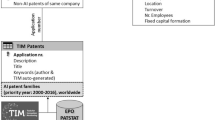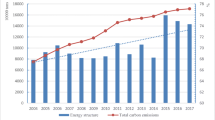Abstract
How technology affects employment has long been debated. In this regard, the recent debate revolves around the impact of Information and Communication Technology (a form of new technology) on productivity and employment. ICT perceived as GPT (general-purpose technology) like steam engines or electricity in the past ushered the world into a new techno-economic paradigm, i.e., it is hard to imagine an economic activity without using it, directly or indirectly. Eventually, ICT investment as a percentage of non-ICT investment (known as ICT intensity) increased significantly over the years in industries across all sectors. How increased ICT intensity affected employment is exactly the question taken up through the paper. To find the answer, on the basis of ICT intensity, industries belonging to the organized sector are categorized into ICT-producing (ICTPS), ICT-using (ICTUS) and non-ICT-using (NICTUS) sectors, with their further division into the manufacturing and the services sector. Empirically, it is found that only the ICTPS witnessed high employment elasticity (EE) with increased ICT intensity since 2000, something found true in both of its segments manufacturing and services sectors, and in both periods Period I (2000–2005) and Period II (2005–2010). In contrast, in ICTUS, EE declined with increased ICT intensity. The trend was found true in both of its constituents. Finally, within NICTUS, in both periods, in both sectors, employment elasticity increased with ICT intensity. In conclusion, for the country as a whole, EE has increased, driven by the services sector, with increased ICT intensity. So, it can be ascertained that new technology in the form of ICT has resulted in a positive employment impact in the services sector, but not in the secondary sectors.
Similar content being viewed by others
References
Balwant Singh Mehta, 2020, Inter-industry linkages of ICT sector in India. Indian Journal of Human Development 14(1):42-61.
Bhalla, A.S. 1997. Facing the Technological Change: A Study. ILO.
Brynjolfsson, E.R.I.K. 2004. The productivity paradox of IT. Communication of the ACM December 1993, 36, 12.
Freeman, C., et al. 1982. Unemployment and Technical Innovation. London: Pinter.
Freeman, C., and L. Soete. 1987. Technical change and full employment. Oxford: Blackwell.
Government of India, Union Budget & Economic Survey Budget 2007–2008.
Gordon, R. J. 2000. Does the ’New Economy’ measure up to the great inventions of the past?. Journal of Economic Perspectives 14(4), Fall.
Harrison, L. et al. 2006. Does Innovation Stimulate Employment? A Firm Level Analysis Using Comparable Micro Data for Four Countries. Available at https://www.crest.fr.
Kumar, A. 2005. Factors underlying jobless growth in India and the need for a new development paradigm. Bhartiya Samajik Chintan 3 (4): 215–29.
Luc, Soete. 1987. Employment, Unemployment and Technical Change: A review of economic debate. In Freeman, C. and Luc, Soete, Technical Change and Full Employment (ed.), Basil Blackwell Publication, London.
NASSCOM, (2012 and 2017) Annual Report, New Delhi.
Nathan, D., and N. Ahmed. 2018. Technological change and employment: Creative destruction. Indian Journal of Labour Economics 61: 281–298.
OECD. 2010. ICT in India: Performance, growth and key challenges, DSTI/ICCP/IE (2008)7 (Final).
Pianta, M. 2000. The employment impact of product and process innovations. In The employment impact of innovation: Evidence and policy, ed. M. Vivarelli and M. Pianta, 77–95. London: Rutledge.
Pissarides, C.A., and G. Vallanti. 2003. Productivity growth and employment: Theory and panel estimates. London School of Economics, London: Centre for Economic Performance.
Rifkin, J. 1995. The end of work. New York: G. P. Putnam’s Sons.
Rogoff Kenneth, 2012: World Economic Forum, https://www.weforum.org/agenda/2012/10/king-ludd-is-still-dead.
Schmidt, H. 1983. Technological change. CEDEFOP, Vocational Training, Berlin: Employment and occupational qualifications’.
Stiroh, J. 2002. Information technology and the U.S. productivity revival: What do the industry data say? The American Economic Review 92(5), 1559–1576.
Vivarelli, M. 2011. Innovation, Employment and Skill in Advanced and Developing Countries, Inter American Development Bank, Technical Notes, No. IDB-TN-351.
Van Ark, B. 2002. Measuring the new economy: An international comparative perspective. Review of Income and Wealth, 48(1), 1–14.
Vivarelli, M., and M. Pianta. 2000. The employment impact of innovation: Evidence and policy. London/ New York: Routledge.
Funding
Sunil Kumar thanks the SERB, the Government of India for providing funding under MATRICS scheme (project no. MTR/2020/000651).
Author information
Authors and Affiliations
Corresponding author
Ethics declarations
Conflict of interest
The authors declare that they have no conflict of interest.
Additional information
Publisher's Note
Springer Nature remains neutral with regard to jurisdictional claims in published maps and institutional affiliations.
Rights and permissions
About this article
Cite this article
Kumar, P., Kumar, S. ICT and Employment in India: An Analysis of Organized Sector. Ind. J. Labour Econ. 65, 373–395 (2022). https://doi.org/10.1007/s41027-022-00370-0
Accepted:
Published:
Issue Date:
DOI: https://doi.org/10.1007/s41027-022-00370-0




